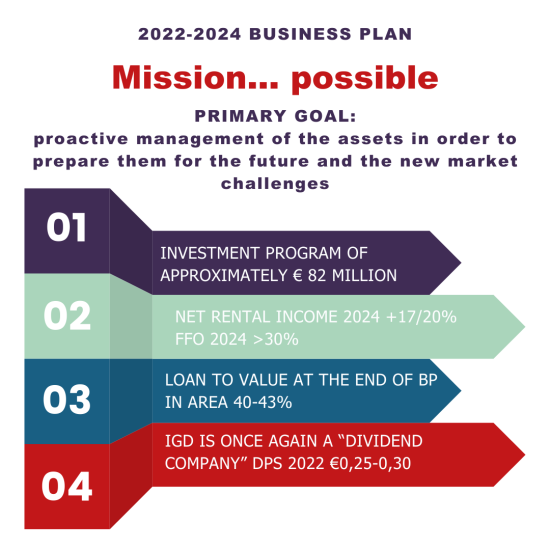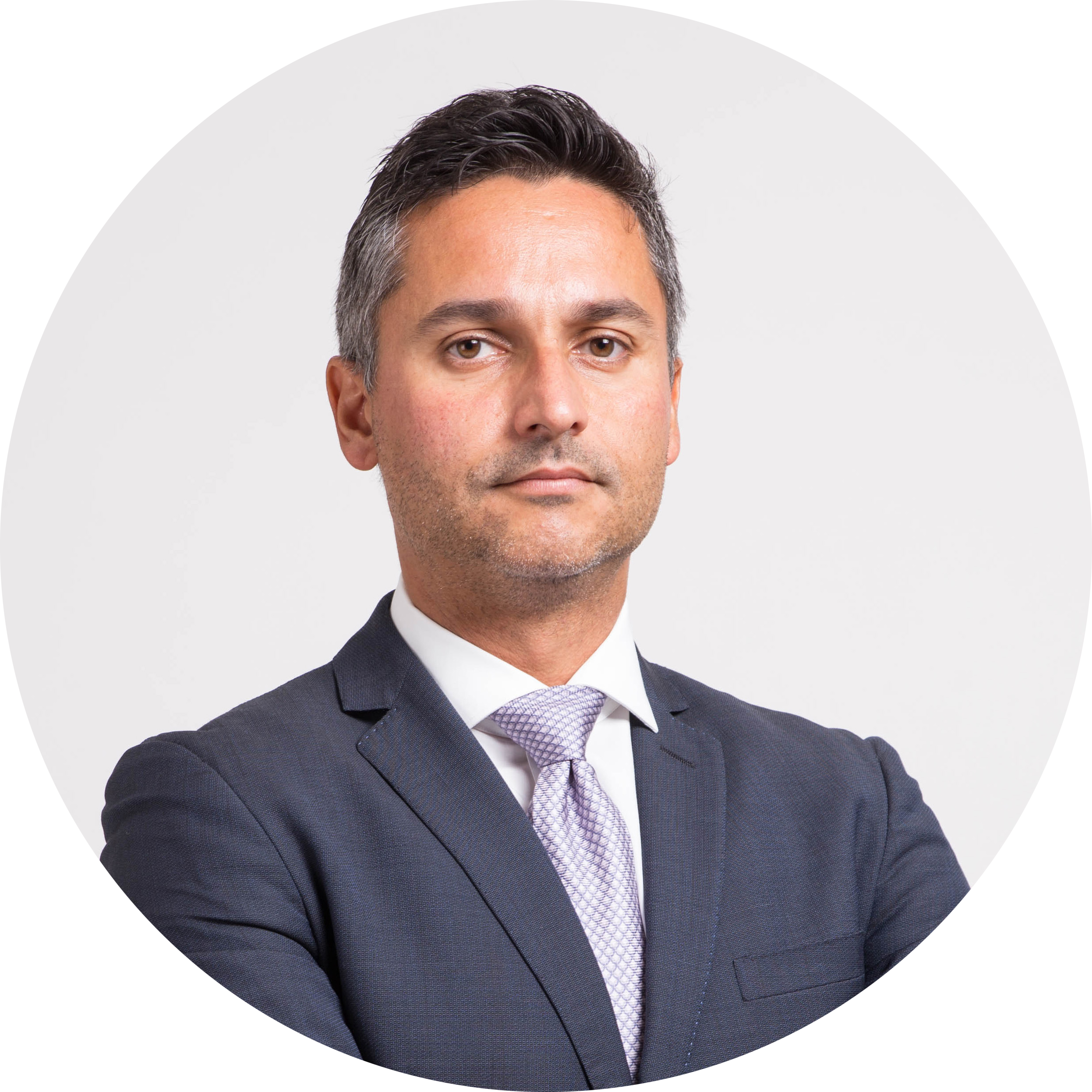A restart plan, challenging but “possible”

On 14 December 2021, IGD presented the new three-year Business Plan 2022-2024. Even though the targets are ambitious, with the name “Mission… possible”, IGD’s management wanted to express its confidence in the ability to reach them.
Let’s ask IGD’s Director of Planning, Control and IR, Raffaele Nardi, a few questions in order to understand the direction that this new Plan will take the strategy and development of the Company.
What makes this Business Plan a “Mission… Possible”, as suggested by the name of the presentation?
The new Plan was conceived at a particular moment in IGD’s history. In 2019, before the pandemic, we had embarked on a solid growth path which had seen key sector indicators like FFO grow at an average rate of 17.5% in the previous five years, while the dividend paid increased by an average of 33% each year. The arrival of COVID-19 then had a severe impact on our activities with 131 days of mandatory closures. As we operated in one of the businesses hit hardest by the restrictions, we had to implement a number of measures in order to give priority to safeguarding financial solidity which involved a few key steps: working with the tenants on exiting the crisis phase, adjusting the lease payment terms and providing temporary rebates, suspending investments that could be delayed, deciding not to pay a dividend for 2020 and the disposal in November of a portfolio of stand-alone hypermarkets and supermarkets. Steps we took convinced that if we maintained a solid financial profile, we would then be able to start a new growth phase which could leverage on the validity of our business model. The encouraging numbers seen in the first months after the reopening, when we were defining the Plan, are now confirmed by the results for FY 2021 which demonstrate the staying power and resilience of our portfolio in terms of both operating performances and market valuations of the properties.
So a Plan put together at a difficult time, but which, however, is geared toward growth…
The Plan is based on a clear, underlying vision. We, in fact, believe in the development opportunities that our sector still provides in Italy, where eCommerce has not exceeded certain levels of penetration even when in-person shopping wasn’t possible or discouraged, as was the case during the first waves of the pandemic. The validity of the format of IGD’s portfolio, comprising urban shopping centers with a dominant position in their respective catchment areas, that are crucial points of reference for customer needs, was also confirmed. We wanted to transmit our take on the vitality of the shopping center business and, particularly, the way we interpret it by calling the Plan “Mission …possible”. While it’s an ambitious plan, it is doable, as the performances seen when the restart began in the second part of 2021 have already demonstrated.
Do you think that the business will reach pre-COVID levels over the life of the Plan?
Thanks to the effective approach we used with tenants, we already closed 2021 with rent collection at 94% and occupancy above 95% in Italy, while at 44.8% the LTV is in line with the 2021 target included in the prior Plan, before the pandemic. We will, therefore, focus on growing organically and without resorting to capital transactions.
How would you summarize the underlying goal for the next three years?
I would say that this Plan is focused, in particular, on the proactive management of the assets, with an approach that is shaped more by the by the specific characteristics of the area of operation, in order to be ready to respond to the new challenges and opportunities that come with changing consumer trends, leveraging on sustainability and innovation.
What actions will you take to implement this strategy?
The idea is to adapt our assets to the needs of the future, in order to make them more appealing and ensure that they stay that way over time: in this way they will be able to preserve market value and extend their life cycles. The investments of around €82 million called for in the plan will be used just for this purpose. A commercial plan was developed based on the uniqueness of each asset, which will result in steps being taken to expand the merchandising mix and revisit the layouts, by also making the most of outdoor areas and creating new spaces dedicated to smart working, in order to keep up with the social transformations underway and the new consumer needs. The organization of events will also meet the growing need for experiences and socialization specific to each catchment area. Another area of great change in our commercial strategy involves digitalization, with activities dedicated to omnichannel development. We set specific targets for the four “digital” areas we identified: CRM and data, customer engagement, tenant engagement and internal innovation.
The commercial strategy is intertwined with the asset management strategy, which includes projects to renew assets (restyling and remodeling) and investments in fit-outs, which account for 24 of the €82 million in Capex, as well as the completion of the Porta a Mare development project in Livorno, to which we will allocate around €13 million, and energy efficiencies including, for example, the installation of the IT devices to optimize the consumption of electricity, increase the green spaces (both inside and outside) to absorb CO2, solar panels and LED lighting for an additional €12 million. We will also dedicate an impressive €33 million to maintaining the high quality of the portfolio assets and ensure the best safety standards. We also included an Asset Rotation, strategy which calls for the potential disposal of non-core assets, for a total of €180-200 million over the life of the Plan: the Romanian chain Winmarkt, as well as three plots of land to developed pertaining to the Porta a Mare project and other stand-alone hypermarkets could be subject to negotiations. The proceeds from these disposals could be used for growth in the Italian retail market, which would generate possible economies of scale, as well as to take advantage of any interesting opportunities that might materialize or reduce financial leverage.
What does the Plan call for in terms of financial management?
Encouraged by the recent improvement in the outlook, which went from Negative to Stable, assigned by the two agencies that rate our debt we aim to maintain rigorous financial discipline, consistent with the investment grade profile in order to limit exposure to financial risks and obtain the best economic conditions possible regardless of the market environment.
What results do you expect these investments will have?
As I was saying, we want to resume growth. Rental income like-for-like is expected to grow at an annual rate of between 5% and 6%, while the growth target for Net Rental Income in the period 2021 restated and 2024 is between 17% and 20%.
Over the life of the Plan FFO is also expected to grow by more than 30% compared to the restated result at year-end 2021, coming in, therefore, at between €74 and €76 million. We expect, lastly, to lower the Loan to Value in a range of between 40% and 43% at 2024. Looking again at finance, at the end of the year we had already managed, thanks above all of the sale closed last November, to cover all the financial maturities for 2022. We will, therefore, strive to refinance the 2023 and 2024 maturities well in advance with a view to prudence and maintaining the maximum flexibility when choosing how to structure the next issues, in terms of both markets and type of instrument.
And in terms of shareholder remuneration?
We intend to confirm our equity story as a dividend company: this is why in December we already planned on paying a dividend of between €0.25 and €0.30 euro per share in 2022, which will then rise subsequently to reach €0.50 per share by 2024. With the dividend of 35 euro cents that the Board of Directors just proposed for 2022 we are, therefore, off to a good start, exceeding the first Plan target.
Did you also set challenging sustainability targets?
Certainly. We identified a total of 41 targets at 2024 and 22 long-term goals through 2030, spread out over the five areas of IGD’s sustainability strategy included in the claim “becoming GREAT”, an acronym for Green, Responsible, Ethical, Attractive, Together. With regard to the environment, one of the most important targets is to have 100% of the Italian shopping centers at zero Scope 1 and Scope 2 carbon emissions and BREEAM certified, while also working to have at least one carbon positive asset. In the 2021 Corporate Social Responsibility Report we also included Scope 3 reporting for the first time in order to be able to proceed with the definition of Science Based Target in 2022.
Are there any risks in the execution of this Plan?
As we said, we are committed 100% to reaching the ambitious, but reachable, targets in this Plan. As is the case with all planning, however, we cannot control the environment in which we operate. We must, above all, mange the scenario risk related, above all, to inflation and consumption: we saw how the Coronavirus managed to impact our operations more than once over the last two years. The key indicators have already begun a path to recovery since the restrictions have been eased, despite the impact that the peak in the infection rate seen in the winter had on different categories of merchandise. The main assumption underlying the Plan is that other closures won’t be necessary in the next few years. Now, however, we are more prepared for any other difficulties that might materialize.
IGD is keeping the door open to possible M&A transactions?
That IGD remains a very valid platform for the aggregation of other assets – and not only in the retail segment – continues to be true: it is also clear that external growth would allow use to reap the benefits of a larger size, leveraging on proven management abilities. These are, naturally, transactions for which the right conditions needed to create value must exist.
Share




